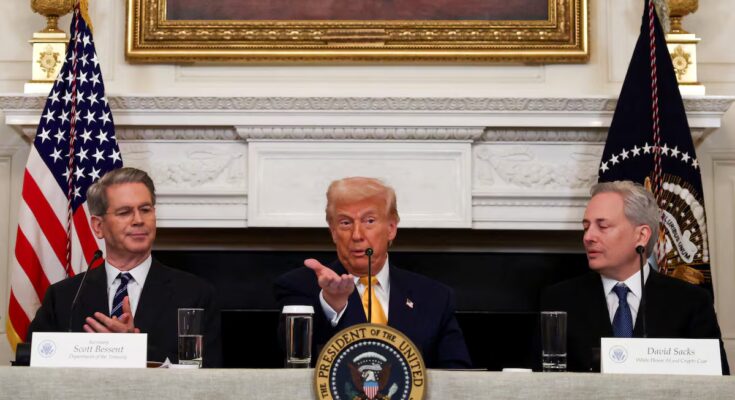On February 4, just two weeks after the second inauguration of US President Donald Trump, the new nominee tsar of artificial intelligence and cryptocurrencies at the White House, David Sacks, explained why the new Administration is betting on stablecoins or stablecoins. As he explained, the tokens Privately issued, dollar-backed digital currencies “have the potential to ensure dollar dominance internationally, increase the digital use of the dollar as a global reserve currency, and, in the process, create potential demand for trillions of dollars in U.S. Treasury securities, which could reduce long-term interest rates.” However, the reality could be very different.
Sacks isn’t the only one to support the stablecoins. Stephen Miran, recently appointed to the Federal Reserve Board by Trump, said in a speech on the 7th that recent US legislation changes the rules of the game not only for the Treasury Department, but also for the Fed. He points out that the widespread adoption of the stablecoins in dollars from residents abroad will not only mean a new and convenient source of financing for the budget deficit, but also a new and explosive source of capital inflows for the economy. A “global excess of stablecoins“, similar to the famous global savings glut identified by former Fed Chairman Ben Bernanke in 2005, will flood the US balance of payments with a flood of foreign money. As with the pre-crisis savings glut, the result will be a natural interest rate (sometimes known as r-star) lowest for the country’s economy. The result is that the Fed will be able to ease monetary policy without stoking inflation any more than it does now.
Miran predicts that the effect will not be insignificant. The Fed itself predicts that demand for stablecoins could reach $3 trillion by 2030, compared to dollar-denominated digital tokens in circulation today, which total around $300 billion, according to CoinGecko. The forecast for 2030 is not far from the total amount of U.S. Treasury securities purchased by the central bank as part of its quantitative easing program during the pandemic. Recent academic modeling suggests that widespread adoption of fully collateralized stablecoins could push US rates down by as much as 0.4 percentage points relative to the counterfactual. Stablecoin-related capital inflows could also cause the dollar to appreciate against other currencies, which would add another disinflationary force and provide even more room to lower rates. Therefore, according to Miran, the impending global saturation of stablecoins represents “a multi-billion dollar elephant in the room of central bankers.”
Stablecoins are new. Dollarization is not. There is a long history of other countries using the dollar to save and pay, whether in cash or bank deposits. Many examples from the pre-war era stablecoins They certainly support Miran’s assertion thatdollarization has significant consequences for macroeconomic policy. But the story also suggests an important reason why America’s stablecoin power play may not go as planned.
The underlying problem is that, despite any benefits to Uncle Sam, the global spread of dollar use comes at an equal and opposite cost to countries whose financial systems are beingdollarized. These costs could be much larger, relative to the size of individual foreign economies, than the positive effects for the United States.
As a result,dollarization has historically been far from a sure bet. Instead, it has fluctuated based on the ability of foreign governments to resist it. In the 1980s and 1990s, high inflation and exchange rate volatility made the use of the dollar an attractive option for businesses and families in poorer economies. A 2003 study by the International Monetary Fund (IMF) found that at the turn of the millennium, the share of bank deposits denominated in foreign currency in a sample of 86 developing countries ranged from just under a third in Asia to more than half in South America.
However, the inconvenient restrictions generated a compensatory response. Policies and institutions have improved in heavilydollarized economies. Governments made central banks independent, which helped control inflation, while liberalizing financial markets and consolidating public finances. Except for a few countries known for their macroeconomic imbalances, such as Turkey and Argentina, the incentives to use the dollar instead of the national currency have declined dramatically. A recent in-depth survey looked at countries that had more than 10% of their bank depositsdollarized in 2000. In more than two-thirds of these cases,dollarization declined over the next two decades, often dramatically.
This historical dynamic teaches us a fundamental lesson. The incentives for the rest of the world to resist the loss of monetary sovereignty are very great. If other countries are proactive in ensuring that their payments and financial systems remain competitive and that their public finances are sustainable, the barriers to dollar colonization are likely to be high. In other words, digital dollarization risks the same fate as analogue, making Miran’s dreams of easy money without inflationary repercussions more unattainable than ever.
A worst-case scenario for the United States
An even scarier scenario is also possible for the United States. The Trump administration’s attempt to gain stablecoin supremacy may not only backfire, but backfire.
Since the birth of the modern international monetary system at the Bretton Woods conference in 1944, other countries have resented having to use the dollar as their de facto international currency. But they were never able to agree on a workable alternative. The British John Maynard Keynes proposed a truly supranational currency, the bancar, managed by a multilateral cooperative, but the idea was immediately rejected by the United States. The closest thing so far was the 1969 introduction of the IMF’s Special Drawing Right (SDR): an international unit of account linked to a basket of the world’s five most liquid reserve currencies, in which the organization denominates its members’ reserves. In 2009, the then governor of the People’s Bank of China proposed increasing SDRs to the bank level. But, once again, the blow against the dollar has faded.
Things could change. The indisputable value of monetary sovereignty means that the rest of the world has always had a reason to end the dollar’s global dominance. IMF SDRs provide the means to do this. The US’s open pursuit of a glut of global stablecoins could now create the opportunity, which would mean the dollar’s date with destiny could finally be near.
The authors are columnists for Reuters Breakingviews. Opinions are yours. The translation, by Carlos Gomez belowit is the responsibility of CinqueGiorni



